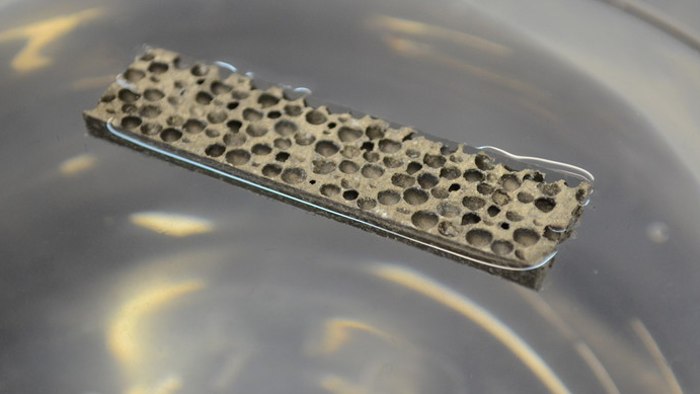In a development that could mean big things in the automotive and marine industries, researchers from Deep Springs Technology (DST) and the New York University Polytechnic School of Engineering have created a new metal matrix composite that is so light it can float on water.
The magnesium alloy matrix composite is what is known as a syntactic foam: a type of composite material created by filling a metal, polymer or ceramic matrix with hollow particles. In this case, a magnesium alloy matrix is reinforced with hollow particles of silicon carbide, resulting in what the researchers claim is the world’s first lightweight metal matrix syntactic foam.
This structure helps give the material a density of 0.92 grams per cubic centimeter, which is less than the 1 g/cc density of water, thereby giving it the ability to float on water and potentially be used in the construction of marine vessels that stay afloat even after experiencing damage to their structure. Furthermore, the researchers say it is also strong enough to withstand rigorous marine conditions.
Additionally, the material also boasts heat resistance properties that would make it a viable alternative to the lightweight polymer matrix composites that have been the focus of much research and development for use in both marine vessels and automobile components as a replacement for heavier metal-based components.
“This new development of very light metal matrix composites can swing the pendulum back in favor of metallic materials,” says Nikhil Gupta, an NYU School of Engineering professor in the Department of Mechanical and Aerospace Engineering and the study’s co-author. “The ability of metals to withstand higher temperatures can be a huge advantage for these composites in engine and exhaust components, quite apart from structural parts.”
The material starts out as a matrix made of magnesium alloy, which is turned into a foam through the addition of silicon carbide hollow spheres developed by DST. These lightweight spheres are extremely strong, with the shell of a single sphere able to withstand over 25,000 PSI of pressure before rupturing. As well as adding strength, the spheres also offer impact protection by acting like an energy absorber.
Modifying the amount of spheres that are added to the matrix allows the composite’s density and other properties to be customized to suit different applications. Just a few potential applications “floated” by the researchers include boat flooring, automobile components, buoyancy modules and vehicle armor. This last example may be related to the fact that the US Army Research Laboratory collaborated on the research.
The team says the material could be in prototypes for testing within three years.
The team’s study appears in the International Journal of Impact Engineering.
Source: NYU Polytechnic School of Engineering
Dear User/Visitor! Please, answer on our questions: tick off one of the positions – your answer will make us able to improve our site and make it more interesting and useful!


